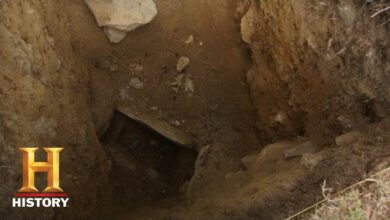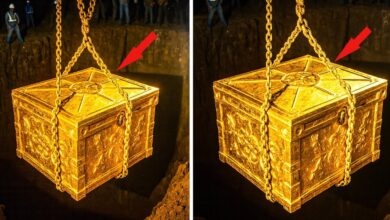The Curse of Oak Island: Evidence Unearthed of British Military Connection (Season 8) | History
The Curse of Oak Island: Evidence Unearthed of British Military Connection (Season 8) | History

Hey Carmen, oh, look at here! Alex Leguiner and Jack Begley arrive at blacksmithing expert Carmen Lake’s shop in Centerville, Nova Scotia. They are eager to have him examine the recent finds made by Jack and metal detection expert Gary Drayton on Lot 15.
“All right, let’s start with this one. So, all right, let’s have a look. You’re gonna know exactly what this is immediately because we’ve come and shown you these before, and we have a couple different oxygen… oh, it’s a knock shoe!”
“Yes, yes, it’s a winter shoe. It’s for the, uh, outside claw to the left front foot. A winter shoe, it’s a winter shoe.”
“What do you mean by winter shoes?”
“They’re fairly sharp here for the ice, hard packs. Now, if it was for a summer shoe, it would be much thicker and wider, and more robust for the rocks and the ground. And for a small animal, probably 1,300 pounds, something like that. Very typical of the earlier time periods. Small British-made shoe.”
“Is there a difference between the shoes that would be used by a British farmer or, you know, something like that, versus what would be used by the British military, or would you?”
“No, this could be British military. Yes, yes, so that’s not the same as the old shoes that we brought you in years past.”
“No, some of them were German, and there was also a few French shoes in there, but this is a British style of shoe that would be anywhere around 1650 to 1750. Early 1700s. Yeah, yeah, this shoe was very typical for the 1700s. The later shoes are the straighter, wider on the heel. Would have used machine-made nails, not handmade nails.”
“Cool, could that mean that the animal these belong to was in some way connected to the mysterious stone structure found on Lot 15? A structure that might also have been involved in the construction of the money pit prior to 1795?”
“It’s an unusual style, it’s a British style. Was it made here by the British? I don’t know. We do have a few more from the same region, right Jack?”
“Yeah, we got a couple different opportunities. My team is much bigger.”
“It’s a winter shoe, so that’s the same time period as the other one, but it’s a little bigger shoe, more likely made by the same maker, just for a bigger animal. Two different animals at least.”
“Yeah, yes.”
“This one here is the same as the other one, um, not for the front foot. This is for the hind foot. This one, however, I can tell is not a winter shoe. It’s a summer shoe.”
“One other interesting thing about the ox shoes is that we found both kinds on Oak Island, in the vicinity of this Lot 15 structure, which indicates that not only was there large-scale industrial or military activity happening, it was happening in two different seasons for at least a decent length of time.”
“All these ox shoes were found in a line that it seemed like someone was hauling something between the swamp and the money pit. And these were all found along the same trail, along the same trail. So, in order to find these many shoes along that route means that there was a major activity, transportation of something going back and forth there. It’s very unusual. Sounds like industry going on. There wasn’t a couple of days. It was several months over a winter and summer period. A massive excavation, possibly.”
“Yeah, well, do you think this piece is related as well?”
“Uh, it’s very corroded. I wish I knew what was underneath that. It does seem to be a bit of a seam going down through the middle there, and again you can see the seam down too there. So, that means it was molded, and it was along the trail. It fell off the ox equipment or off of the conveyance.”
“The only thing that could possibly be is sort of like a finial on top of an ox cart. Just a decorative talk, not civilian. If it was an off cart, it would be military because that’s the only ones that would use any scrollwork or knob work on their ox cart or wagon finials.”
“What you identified, all the other objects, really makes me think there was an old British military operation of sorts between the swamp and the money pit, or that’s what it appears to be.”
“We haven’t finished detecting the area, so we’ll have to go back and see what else we can find. We’ll go back out there and look for some more stuff.”
“Thank you very much.”
“All right, very good. Very good. Thanks for all the… thank you, man. We’ll see you soon, Carmen. Take care.”
“Okay, see you later.”








